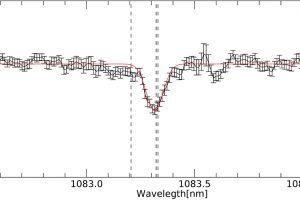Exoplanets with extended evaporating atmospheres. The study: “The GAPS programme at TNG. XXII: The GIARPS view of the extended helium atmosphere of HD 189733 b accounting for stellar activity” of G. Guilluy (UniTO/INAF-OATo) recently appeared on A&A

The number of known exoplanets discovered so far (4197 planets, updated at 2020/August/4th, from NASA) is large enough to allow us to study their global properties. One of these properties, still lacking a proper explanation, is the so-called “Neptunian desert”, e.g. the lack of intermediate planets with orbital periods shorter than 3 days. One of the hypotheses that can explain the Neptunian desert is that gaseous planets in close orbits loose a significant fraction of their mass because of the intense incident stellar radiation. Planets orbiting close to their stars, in fact, can be irradiated by intense X-rays and UV radiation, produced by the magnetic activity of their stars (mainly flares). This radiation heats the gas in the atmospheres, which expands and acquire an mean velocity even higher than the gravitational escape velocity. In these cases, thus, the atmosphere can be quickly dispersed in space.
Atmospheres are studied by analysing spectroscopic observations acquired during the transits, e.g. when planets are moving through the disk of their stars. During the transits, in fact, part of the stellar radiation pass through the atmosphere and it can be absorbed by its gases, allowing us to study properties and chemistry of the atmospheres. The first evidence suggesting the presence of puffed evaporating atmospheres in gaseous planets in close orbits was obtained from the analysis of absorption Hydrogen lines during the transits of the planet HD 209458 b, from observations obtained with STIS mounted on the Hubble Space Telescope. Hydrogen lines, however, can be affected by interstellar absorption and geocoronal emission. Another useful diagnostic to this aim is the HeI 1083.3 nm triplet, which is not affected by interstellar absorption. In order to study the HeI 1083.3 nm triplet in the spectra of exoplanets, however, it must be properly taken into account the stellar magnetic activity. In fact, on one hand it is necessary that the atmosphere is irradiated by EUV (extreme UV) photons, produced by the phenomena associated with the stellar magnetic activity, in order to produce a significant atmospheric signal at 1083.3 nm. On the other hand, this absorption line can be affected by the magnetic activity when the planet transits over a magnetically active region, such as a faculae network or spots.
The analysis of the absorption HeI 1083.3 nm line requires thus a proper analysis of the stellar activity during the transits. This is the approach adopted by the team led by the astronomer G. Guilluy (University of Turin, INAF-Astronomical Observatory of Turin) to study the atmosphere of the planet HD 189733 b (a Jovian planet orbiting a G-type star at a distance of 0.03 Astronomical Units, about a tenth of the mean Sun-Mercury distance). The study is part of the GAPS project (Global Architecture of Planetary Systems), and it is based on observations acquired during five transits in optical and infrared with the spectrographs GIANO and HARPS-N mounted on the Italian Galileo National Telescope. The authors have observed during the transits the absorption line HeI 1083.3 nm, due to the atmosphere of the planet. In particular, the availability of simultaneous observations in optical and infrared provided powerful diagnostics to study the activity of the star, allowing the authors to identify three transits in which the HeI 1083.3 nm is not affected by the activity. From simulations aimed at reproducing the absorption feature observed in these three transits, the authors have estimated that the atmosphere of the planet is heated up to 12000 degrees, it extends over 1.2 planetary radii, and is losing Helium at the rate of 1−2 g s−1 . The study is described in the paper: “The GAPS programme at TNG. XXII: The GIARPS view of the extended helium atmosphere of HD 189733 b accounting for stellar activity“, recently appeared on the journal Astronomy & Astrophysics. Among the coauthors, the astronomers L. Affer, S. Benatti, A. Maggio, J. Maldonado e G. Micela of INAF – Astronomical Observatory of Palermo.
The image (click here to visualize the entire figure) shows the average over the five transits of the transmission spectrum of HD 189733 b. The nominal positions of the HeI 1083.3 nm triplet are marked with vertical lines. The absorption feature is clearly evident.
Mario Giuseppe Guarcello ( follow mguarce)
